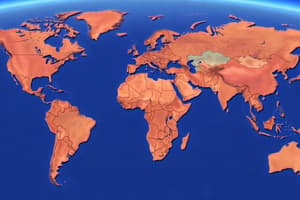Podcast
Questions and Answers
What does population refer to in human geography?
What does population refer to in human geography?
- The total number of people living in a specific area (correct)
- The movement of people from one location to another
- The number of people living in a certain area
- The arrangement of people across spaces
Which term refers to the arrangement of people across spaces and the factors that influence these patterns?
Which term refers to the arrangement of people across spaces and the factors that influence these patterns?
- Migration
- Density
- Distribution (correct)
- Diversity
In human geography, what is density related to when discussing population?
In human geography, what is density related to when discussing population?
- The range of human characteristics that contribute to the makeup of a population
- The movement of people from one location to another
- The factors that influence the arrangement of people across spaces
- The number of people living in a certain area (correct)
Which factor shapes population distribution and diversity according to the text?
Which factor shapes population distribution and diversity according to the text?
What does migration refer to in human geography?
What does migration refer to in human geography?
Which term represents the range of human characteristics contributing to the makeup of a population?
Which term represents the range of human characteristics contributing to the makeup of a population?
What are push and pull factors in the context of migration?
What are push and pull factors in the context of migration?
Which perspective views people as actively shaping and being shaped by their environment?
Which perspective views people as actively shaping and being shaped by their environment?
What does circular migration refer to?
What does circular migration refer to?
What is the main focus of location theory in human geography?
What is the main focus of location theory in human geography?
Which of the following is NOT a factor that can drive individuals to relocate?
Which of the following is NOT a factor that can drive individuals to relocate?
Why is understanding population and migration crucial in human geography?
Why is understanding population and migration crucial in human geography?
Flashcards are hidden until you start studying
Study Notes
Exploring the Foundations of Human Geography: Population and Migration
Human geography, a branch of geography that focuses on the spatial patterns and processes of human activity, delves into various aspects that shape our world. Two key subtopics within this discipline are population and migration. Understanding these foundational concepts is crucial to comprehending the dynamic nature of human settlements and the intricate web of relationships between people and their environments.
Population
Population, defined as the total number of people living in a specific area, is a critical component of human geography. Several aspects related to population are vital for understanding human-environment interactions:
- Distribution: The arrangement of people across spaces and the factors that influence these patterns.
- Density: The number of people living in a certain area, usually expressed as inhabitants per unit area.
- Diversity: The range of human characteristics, such as age, sex, race, ethnicity, religion, and education, that contribute to the makeup of a population.
These elements are interconnected, with factors like natural resource availability, transportation infrastructure, and cultural traditions shaping population distribution and diversity.
Migration
Migration refers to the movement of people from one location to another, either temporarily or permanently. This subtopic of human geography is a crucial component of understanding current global population dynamics and trends. Some key aspects of migration include:
- Push and pull factors: Factors that compel individuals to move from one location to another, or factors that attract them to a particular area.
- Circular migration: Short-term or seasonal migration, where individuals return to their original location after a time.
- Chain migration: The migration of multiple members of a social network or chain from one location to another.
Migration patterns are as varied as the reasons behind them, with factors such as poverty, political instability, natural disasters, and economic opportunities driving individuals to relocate.
Geographical Perspectives
The study of population and migration in human geography is multifaceted and includes several geographical perspectives. These perspectives aim to understand the complex relationships between people and their environment from different lenses, such as:
- Deterministic perspective: People are seen as passive recipients of environmental influences.
- Interactionist perspective: People actively shape and are shaped by their environment.
- Location theory: The geographical position of a population, or its location, is a crucial factor affecting its well-being.
These perspectives help us to better understand population and migration dynamics and their profound impact on the distribution, density, and diversity of human populations.
Conclusion
Understanding the fundamental concepts of population and migration in human geography is essential for comprehending the complex relationships between people and their environment. By examining these critical aspects of human geography, we can better understand the forces shaping our world and develop innovative solutions to address global challenges like urbanization, demographic change, and social inequality.
Studying That Suits You
Use AI to generate personalized quizzes and flashcards to suit your learning preferences.




